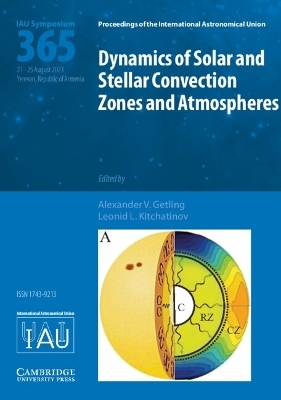
Dynamics of Solar and Stellar Convection Zones and Atmospheres (IAU S365)
Cambridge University Press (Verlag)
978-1-108-49077-1 (ISBN)
- Noch nicht erschienen (ca. Dezember 2024)
- Versandkostenfrei innerhalb Deutschlands
- Auch auf Rechnung
- Verfügbarkeit in der Filiale vor Ort prüfen
- Artikel merken
Impressive events of magnetic energy release, such as solar and stellar flares and coronal mass ejections, take place in the atmospheric layers above a star's photosphere. These magnetic-activity events are closely related to the dynamics of subsurface convection zones inside the star. IAU Symposium 365 was devoted to observational and theoretical aspects of solar and stellar hydrodynamics and magnetohydrodynamics, both global and local, including numerical studies. The last few decades have been marked by substantial progress in our understanding of the physics of internal and external processes in the Sun and solar-type stars, but the scientific communities making this progress have not traditionally worked closely together. This symposium, delayed due to the COVID pandemic, brought together specialists in the physics of convection zones and atmospheres, to stimulate the emergence of new ideas and to develop new techniques in this dynamic field of active research.
Section 1. Solar and Stellar Convection: Effects of rotation and surface forcing on deep stellar convection zones P. J. Käpylä; Analyzing magnetic network and its variations over Solar Cycles 23, 24 and 25 based on magnetic power spectra Y. Luo, J. Jiang and R. Wang; Imaging stellar surface features with optical interferometry X. Haubois; Section 2. Differential Rotation and Meridional Circulation: Differential rotation of the solar chromosphere using multidecadal Ca II K spectroheliograms D. K. Mishra et al.; A frequency-dependent method for measuring the Sun's interior meridional circulation R. Chen and J. Zhao; Probing the Sun's near surface shear layer using HMI spherical harmonic coefficients S. C. Tripathy, K. Jain, S. Kholikov and R. Komm; Rotational shear in the low photosphere of the Sun T. Corbard, M. Faurobert et al.; Near-surface shear layer of solar rotation: origin and significance L. Kitchatinov; The near-surface shear layer (NSSL) of the Sun: a theoretical model A. R. Choudhuri and B. K. Jha; Differential rotation of stars from spot transit mapping: dependence on rotation period and effective temperature A. Araújo and A. Valio; Short and long term spot evolution on EI Eri L. Kriskovics et al.; Magnetic activity under tidal influences in the 2+2 hierarchical quadruple system V815 Herculis Zs. Kὅvári et al.; Section 3. Global dynamo. Solar and Stellar Activity Cycles: Recent developments in the Babcock–Leighton solar dynamo theory B. B. Karak; Nonlinear and stochastic mechanisms of the solar cycle and their implications for the cycle prediction J. Jiang; A new generation of solar dynamo model and its application to explore the stellar magnetic cycle Z. Zhang; Resonance and stellar dynamos D. Sokoloff, E. Yushkov and A. Serenkova; The role of nonlinear toroidal flux loss due to flux emergence in the long-term evolution of the solar cycle A. Biswas; Dominating active regions in the minima of solar activity R. A. Suleymanova and V. I. Abramenko; Solar cycle variability induced by stochastic fluctuations of BMR properties and at different amounts of dynamo supercriticality Pawan Kumar; Exploring the predictability of the solar cycle from the polar field rise rate: Results from observations and simulations A. Biswas; The North–South asymmetry of the number and magnetic fluxes of active regions of different magneto-morphological types in cycles 23 and 24 A. Zhukova; Prognostic opportunity of the shifted correlation Between Wolf numbers and their time derivatives S. V. Starchenko and S. V. Yakovleva; Chromosphere activity: relations with solar cycles S. Koutchmy and E. Tavabi; Modelling the rotation dependence of cycle variability in sun-like stars: Answering why only slowly rotating stars produce grand minima V. Vashishth; On origin of active/inactive branches on moderate rotating solar analogs V. V. Pipin; Section 4. Helioseismology and Asteroseismology: Recent progress in time–distance helioseismology: meridional circulation, far-side imaging, and sunquakes R. Chen and J. Zhao; Convection, rotation, and magnetic activity of solar-like stars from asteroseismology S. Mathur; Solar inertial modes L. Gizon et al.; A 2D model for the excitation of the linearly stable inertial modes of the Sun by turbulent convection J. Philidet and L. Gizon; Temporal variation of solar equatorial Rossby modes with azimuthal orders 6 <= m <= 10 B. Lekshmi et al.; Observational study of Reynolds stresses associated with solar inertial modes Y. Mandowara et al.; Probing the superadiabaticity of the solar convection zone with inertial modes P. Dey et al.; Effects of small-scale magnetic fields in the photosphere on surface effects for solar-like stars G. Lin, Y. Li, T. Wu and S. Jie; The effect of Coulomb interactions on acoustic oscillations in the outer layers of low-mass stars A. Brito and I. Lopes; Section 5. Local Processes of Ma
| Erscheinungsdatum | 23.08.2024 |
|---|---|
| Reihe/Serie | Proceedings of the International Astronomical Union Symposia and Colloquia |
| Zusatzinfo | Worked examples or Exercises |
| Verlagsort | Cambridge |
| Sprache | englisch |
| Themenwelt | Naturwissenschaften ► Physik / Astronomie ► Astronomie / Astrophysik |
| ISBN-10 | 1-108-49077-8 / 1108490778 |
| ISBN-13 | 978-1-108-49077-1 / 9781108490771 |
| Zustand | Neuware |
| Haben Sie eine Frage zum Produkt? |
aus dem Bereich


